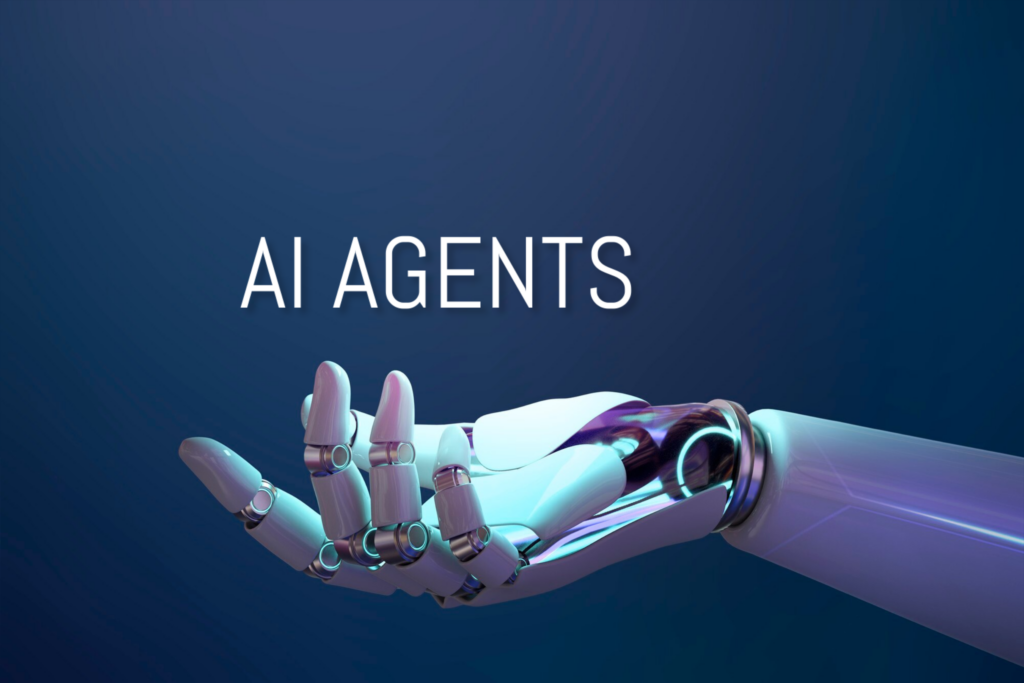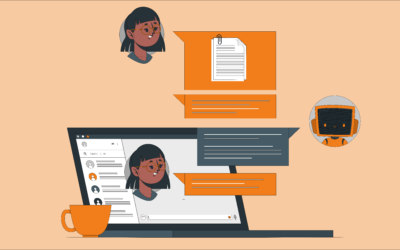Table of Content
- What Are AI Agents?
- What Are Agentic Workflows?
- What Are Multi-Agent Systems?
- Building AI Agents
- Agentic Collaboration
- Delegation in Multi-Agent Collaboration
- Dynamic Prompt Templating for Agent Adaptation
- Use Cases for AI Agents
- Tools for Integrating with AI Agents
- AI Agent Frameworks and Platforms
- The Role of AI Agents in Business Workflows
- Key Takeaway
- Krasamo’s AI Development Services
Businesses’ rapid adoption of generative AI is reshaping industries at an unprecedented pace. Enterprises worldwide are investing billions in generative AI solutions, creating opportunities to enhance efficiency and reduce costs.
AI agents—autonomous systems powered by advanced large language models (LLMs)—are experiencing strong market demand and are poised to replace certain traditional software applications.
AI agents bring unparalleled flexibility and adaptability to business workflows. Unlike conventional systems, they can independently execute tasks, interact with tools, and optimize operations dynamically. Their modular and scalable nature aligns perfectly with modern enterprises’ growing demand for automation and intelligent decision-making.
By integrating agentic workflows, businesses can seamlessly orchestrate complex processes through collaboration among specialized AI agents, replacing outdated monolithic applications.
With advancements in frameworks, platforms, and low-code tools, organizations can quickly design and deploy AI agents tailored to their unique needs.
This blog post explores the foundational concepts of AI agents and multi-agent systems, the opportunities they create for businesses, and their role in shaping the future of software applications. It also provides actionable insights for organizations looking to embrace this transformative technology and stay ahead in the rapidly evolving AI-driven economy.
Krasamo is a U.S.-based AI development company with expertise in AI agents, AI Copilots, RAG applications, and other Generative AI applications.
What Are AI Agents?
AI agents are autonomous entities powered by large language models (LLMs). They can execute tasks, make decisions, and adapt their responses using defined roles, goals, backstories, and toolkits. These agents operate in environments characterized by “ambiguous” inputs, transformations, and outputs, enabling dynamic and context-aware problem-solving. AI agents utilize memory to plan future interactions and can employ guardrails to ensure consistency and prevent errors, making them highly versatile in handling complex workflows.
What Are Agentic Workflows?
Agentic workflows are structured processes where multiple AI agents collaborate to accomplish intricate tasks. These workflows break down complex objectives into subtasks, each assigned to specialized agents with distinct roles and responsibilities. Agentic workflows emphasize the cooperation, delegation, and execution of tasks among agents, ensuring efficiency and precision. Integrating tools, memory, and predefined roles within these workflows facilitates dynamic problem-solving, adaptability, and scalable automation across various domains.
What Are Multi-Agent Systems?
Multi-agent systems are advanced frameworks of multiple AI agents working collaboratively to achieve complex objectives. Building on the foundational principles of AI agents and agentic workflows, these systems represent a significant leap in capability, scalability, and efficiency. Each agent within a multi-agent system is tailored to a specific role, enabling specialization and fostering cooperation across the system. These are some of the main characteristics of multi agent systems:
- Role Specialization: Each agent in a multi-agent system is assigned a distinct role. For example, in a content creation workflow, there might be separate agents designated as researchers, writers, and editors. This role-based design allows each agent to focus on its core function, ensuring higher precision and productivity.
- Collaboration: Agents within these systems are designed to collaborate by delegating tasks, sharing information, and providing feedback to one another. This cooperative mechanism ensures that tasks are completed efficiently and to a higher quality standard. For instance, a research agent may gather data, which the writing agent uses to draft content, followed by an editor agent refining the final output.
- Dynamic Task Execution: Multi-agent systems support dynamic workflows that can execute tasks sequentially, hierarchically, or in parallel. This adaptability allows the system to address diverse use cases ranging from simple task automation to intricate multi-step processes, such as financial analysis or event planning.
- Integration with Tools and Memory: These systems leverage external tools, such as APIs or search engines, alongside built-in memory capabilities. Short-term memory facilitates context sharing during a task, while long-term memory ensures that agents learn from past interactions to improve future performance.
Building AI Agents
Creating AI agents involves a structured approach to defining roles, setting goals, assigning tools, and implementing mechanisms that enable autonomy and collaboration. The following steps outline the creation process:
- Define the Role and Purpose: Each agent is assigned a clear role that dictates its function within the system. For instance, roles like content planner, writer, or editor are tailored to specific tasks. The role includes a detailed description to ensure the agent’s actions align with the intended outcomes.
- Set Goals and Backstories: The goal specifies what the agent aims to achieve, such as planning content or analyzing data. Backstories provide additional context, enhancing the agent’s ability to perform effectively by simulating real-world expertise, such as acting as a senior representative or specialist.
- Assign Tools and Capabilities: Tools extend the agent’s abilities to interact with external systems, such as APIs, web search engines, or databases. These tools are provided either at the agent level for general use or at the task level for specific purposes. Proper tool selection ensures agents can execute their tasks effectively.
- Implement Guardrails and Memory: Guardrails ensure that agents remain within predefined boundaries, avoiding errors like excessive looping or irrelevant actions. Memory allows agents to store and recall information, whether short-term or long-term, enabling improved performance and continuity between tasks.
- Design Task-Driven Interactions: Agents are paired with tasks that define their responsibilities, expected outputs, and the sequence of operations. Tasks are designed to be granular and focused, promoting clarity and reducing complexity in execution.
- Enable Collaboration and Delegation: Multi-agent systems benefit from collaboration, where agents share information and delegate tasks to one another. This approach mirrors teamwork in human settings, ensuring efficiency and higher-quality results.
- Deploy and Test: Once roles, tools, and tasks are set, the agents are integrated into a system and tested. Frameworks like Crew AI provide structured methods for assembling agents, defining workflows, and executing tasks in a controlled environment.
This structured approach transforms raw AI capabilities into specialized, goal-oriented agents that work autonomously or collaboratively to achieve complex objectives.
Agentic Collaboration
Agentic collaboration enables multi-agent systems to dynamically coordinate tasks through sequential, parallel, and hierarchical workflows. This flexibility allows businesses to tailor workflows to specific operational needs, ensuring efficiency, adaptability, and higher-quality outcomes. Whether managing simple or complex tasks, these strategies empower agents to optimize collaboration and deliver results aligned with organizational goals.
Core Collaboration Strategies
- Sequential Workflows: Tasks are passed from one agent to another in a step-by-step manner. While straightforward, this approach can have drawbacks, such as the risk of losing context over time.
- Parallel Execution: Multiple agents perform tasks simultaneously to improve efficiency. This strategy is ideal for independent or loosely coupled tasks that do not require sequential dependencies.
- Hierarchical Processes: A manager agent delegates tasks to worker agents, oversees progress, reviews results, and requests necessary improvements. This approach ensures alignment with overarching goals and is particularly effective for complex, interdependent tasks.
Adaptability in Multi-Agent Systems
Multi-agent systems can dynamically switch between these collaboration strategies based on task requirements. This adaptability ensures workflows are optimized for task complexity, dependencies, and the need for efficiency or precision.
Delegation in Task Execution
Delegation is a key feature of multi-agent systems. It enables efficient task management and execution by leveraging the strengths of specialized agents. It allows tasks to be dynamically assigned to agents best suited for the role, improving performance, scalability, and adaptability.
Key Aspects of Delegation
- Role-Based Assignment: Agents with specific expertise handle delegated tasks to ensure efficiency. Example: A “Researcher” agent gathers information, which is then passed to a “Writer” agent for drafting.
- Dynamic Reassignment: Delegation is not static; tasks can be reassigned to other agents when additional expertise or resources are needed. Example: A “Quality Assurance” agent might request revisions from a “Writer” agent to improve task output.
- Task Prioritization: Delegation includes prioritizing tasks based on urgency, complexity, or dependencies. Example: A “Manager” agent may delegate high-priority subtasks to agents capable of completing them quickly.
- Error Handling and Feedback: Delegation supports a feedback loop where agents critique outputs, identify issues, and delegate follow-ups to resolve errors. Example: An agent reviewing a customer support response can delegate improvements to the original agent or another specialized agent.
Benefits of Delegation in Task Execution
- Specialization: Delegation ensures that each task is handled by the most capable agent, leveraging expertise for better results.
- Efficiency: Tasks can be executed simultaneously or reallocated dynamically, reducing bottlenecks and improving overall system efficiency.
- Adaptability: Delegation allows systems to respond flexibly to unexpected changes, such as new priorities or task dependencies.
Delegation in Multi-Agent Collaboration
In collaborative workflows (e.g., hierarchical or parallel), delegation plays a critical role in enabling agents to share the workload efficiently. This process supports:
- Seamless transitions between tasks across agents.
- Better handling of interdependencies in complex workflows.
- Dynamic adjustments to align with task execution goals.
Dynamic Prompt Templating for Agent Adaptation
Multi-agent systems demand that each agent’s instructions and internal reasoning adapt seamlessly to changing contexts. Dynamic prompt templating achieves this by letting you define reusable templates—whether for system messages, user prompts, or chain-of-thought scaffolds—that include named placeholders (e.g. {topic}, {findings}, {customer_id}).
At runtime, when an agent begins its task or reacts to new inputs from the environment or other agents, those placeholders are automatically filled with the precise data it needs. Templates can draw on:
- Real-time observations or sensor data
- Outputs returned by peer agents
- Specific parameters for the subtask (e.g. target audience, product details)
- Updated goals or contextual flags
Key Benefits of Dynamic Prompt Templating
- Enhancing Flexibility: Agents handle a broad array of scenarios from one template—no bespoke code for each variation.
- Improving Reusability: Define core logic once as a template; apply it everywhere by swapping in different values.
- Streamlining Maintenance: Tweaking behavior means editing a central template, not hunting through dozens of hard-coded prompts.
- Boosting Contextual Awareness: Peer outputs and live inputs plug directly into an agent’s reasoning, ensuring coherent, collaborative workflows.
By leveraging dynamic prompt templating, multi-agent systems become more adaptable, robust, and maintainable, empowering each agent to respond precisely to the unpredictable, interwoven demands of real-world tasks.
Use Cases for AI Agents
- Customer Service: AI agents collaborate to deliver efficient, personalized customer support by handling inquiries, resolving issues, and providing real-time assistance.
- Research: Agents work together to collect and analyze data from diverse sources, streamlining the gathering of actionable insights.
- Content Creation: AI agents generate creative outputs such as articles, code, or scripts tailored to specific requirements and audiences.
- Business Operations: Routine tasks and workflows are automated by AI agents, optimizing efficiency and reducing manual effort.
- Sales and Lead Prioritization: AI agents use scoring tools, CRM integrations, and competitive analysis to identify and prioritize high-value leads. They support lead profiling and execute personalized outreach campaigns, including research, engagement strategies, and communication.
- Customer Support Automation: Agents leverage tools like web scraping, database queries, and FAQ systems to deliver accurate and contextually relevant responses in real time.
Tools for Integrating with AI Agents
AI agents in multi-agents systems are equipped with tools that enable them to interact with the external world, bridging the gap between internal reasoning and structured external environments. Tools allow agents to perform actions such as API calls, data scraping, and notifications.
Tool levels
Depending on the system’s requirements and objectives, tools are assigned to two levels: agent level and task level.
Tools at the Agent Level
When tools are assigned at the agent level, they become a core part of the agent’s default toolkit, accessible for any task it undertakes. This method provides the agent with the flexibility and autonomy to decide how and when to use its tools, making it well-suited for roles that require certain capabilities in a wide variety of contexts. The primary benefits are enhanced versatility and a reduction in the need for constant system reconfiguration.
A clear example is a “Support Agent” equipped with a search engine. Because this tool is available at the agent level, the agent can independently use it to resolve any customer inquiry it faces. It can search for documentation related to installation, look up troubleshooting guides, or find billing information, all using the same core tool without restriction.
Tools at the Task Level
Tools can be assigned at the task level to provide an agent with the specific capabilities needed for a particular job. When this is done, these task-specific tools override any default tools the agent might normally possess. This method offers tighter control by restricting the agent to a curated set, ensuring focus and preventing it from being overloaded with unnecessary functions. As a result, it reduces the risk of tool misuse and improves the accuracy and performance of the task at hand.
To illustrate, consider an agent assigned a “Document Scraping” task. It would be equipped exclusively with a web scraper tool and would be unable to access any other tools, even if they are part of its default configuration. This focused approach guarantees that the agent executes the scraping task efficiently and without distraction.
Choosing and Optimizing Tools
When integrating tools with AI agents, it’s essential to consider their functionality, robustness, and impact on performance.
- Diverse Input Handling: Tools should handle a variety of inputs, converting LLM-generated data into structured formats needed for external systems.
- Fault Tolerance: Tools must manage unexpected issues, such as network errors or invalid data, to ensure uninterrupted execution. Crew AI, for instance, includes error-handling and self-healing mechanisms.
- Smart Caching: Tools should include caching mechanisms to minimize unnecessary external requests, optimize performance, and save time. Features like cross-agent caching allow agents to share cached results for similar requests, reducing duplicate efforts and resource consumption while maintaining rate limits.
Examples of Common Tools
- Search Engine SERP Tool: Searches the internet for relevant information.
- Semantic Search Tools: Retrieve contextually relevant information from structured databases.
- Document Scrapers: Extract specific data from documents or websites.
- Database Connections: Query databases for structured data.
- API Call Tools: Interact with external systems via API endpoints.
- File Read Tool: Extracts data from local files.
- Directory Read Tool: Reads instructions or company-specific guidelines.
By understanding and strategically assigning tools, organizations can ensure AI agents perform their tasks efficiently, accurately, and with minimal resource consumption.
AI Agent Frameworks and Platforms
AI agent frameworks and platforms offer essential tools for building and deploying AI agents, catering to different levels of technical expertise and development needs.
Frameworks provide the building blocks for creating AI agents, such as memory systems, reasoning engines, and action-planning modules. Developers gain control over the underlying mechanisms and can customize agent behavior to a high degree.
Platforms offer a more user-friendly interface for building and deploying AI agents. They often include pre-trained models, templates, and automation tools to streamline development. Platforms handle tasks like data preparation, model training, and deployment, making creating AI agents easier for non-technical users.
LangChain
LangChain is a framework often used as a foundation for building AI agents and applications. It provides tools for managing prompts, memory, and execution, enabling the creation of multi-agent systems.
Vertex AI Agents
Vertex AI Agent Builder simplifies the creation and deployment of conversational AI agents on Google Cloud. It integrates advanced language models, no-code interfaces, and automation tools to streamline development. Vertex AI supports use cases such as customer support, task automation, and enhanced conversational workflows.
Crew AI
Crew AI is a framework for orchestrating autonomous AI agents with specific roles, tools, and goals. It facilitates collaboration among agents, manages workflows, and automates complex tasks. Crew AI leverages role-based agents, intelligent coordination, and seamless integration with external tools.
Agentforce
Agentforce, from Salesforce, is an advanced AI platform for building proactive, autonomous AI agents. It enables businesses to automate tasks across roles and industries, leveraging trusted data, guardrails, and integrations to deliver accurate, scalable, and context-aware agent-driven solutions across multiple channels.
The Role of AI Agents in Business Workflows
AI agents are critical for business workflows as they bring unparalleled efficiency, scalability, and adaptability to modern operations. By automating repetitive and time-consuming tasks, agents free human teams to focus on strategic and creative work, driving higher value. Their ability to process vast amounts of data, identify patterns, and deliver actionable insights enhances decision-making beyond traditional methods.
In customer-facing and marketing roles, AI agents provide personalized interactions tailored to individual users, boosting engagement and improving user experiences. Operating 24/7, they ensure continuous functionality, which is particularly valuable in global markets and customer service workflows.
Scalability is another key advantage, enabling businesses to handle increasing workloads without scaling human resources proportionally. This, in turn, drives cost efficiency, as agents reduce reliance on labor-intensive processes while maintaining high-quality outputs. AI agents also bring agility to workflows, rapidly adapting to new data and changing requirements, ensuring resilience against disruptions. Acting as integrators, they bridge disparate systems, allowing seamless data flow and fostering coordinated operations across platforms. These capabilities make AI agents indispensable for businesses looking to optimize workflows and maintain a competitive edge.
Key Takeaway
Designing and implementing multi-agent systems requires a structured approach to ensure effectiveness and reliability. The process begins with a clear goal definition, identifying specific business objectives like automating processes, analyzing data, or enhancing decision-making.
Breaking down complex workflows into manageable tasks is essential, with agents assigned defined roles, goals, and backstories to maintain focus and relevance. Effective collaboration and communication among agents, whether through sequential, parallel, or hierarchical processes, further enhances efficiency and adaptability.
Agents must be equipped with appropriate tools such as APIs, web scraping utilities, and database queries, ensuring they are versatile, fault-tolerant, and supported by caching mechanisms for seamless performance.
To maintain consistency, implementing guardrails prevents errors like repetitive loops or hallucinations. Memory mechanisms, including short-term, long-term, and entity memory, allow agents to learn from past interactions and refine their outcomes over time. Finally, iterative testing and refinement in simulated environments help gather insights, improve behaviors, and optimize performance, enabling robust and effective multi-agent systems.
Krasamo’s AI Development Services
Are you ready to streamline your team’s workflows with AI agents?
What inefficiencies could multi-agent collaboration solve for your organization?
Every organization has unique needs. Our team specializes in build AI Agents that integrate seamlessly into your workflows, optimizing processes and driving measurable results.
Contact us today to learn how AI agents can transform your operations and explore tailored solutions designed specifically for your business.












I concur with the author’s emphasis on robust tool selection for AI agents development.
I think you could’ve delved deeper into implementation strategies for multi-agent systems, especially in relation to current tools available.
Love how you illustrate generative AI strategy w/ agent-level tooling 🤖🔧
As an AI engineer with experience in building intelligent systems, I wholeheartedly agree with the importance of designing guardrails and implementing task-driven interactions. However, in ai app development, it’s equally crucial to consider the nuances of user expectations and feedback loops to ensure seamless agent-human collaboration.
Great post! Agentic collaboration is indeed a crucial aspect of multi-agent system design. I’d love to discuss how AI agents can leverage adaptive workflows to optimize outcomes in complex environments. What are your thoughts on hierarchical processes vs sequential workflows for task delegation? Are there any real-world examples where adaptability has made a significant impact?
You’re being very generic with your questions… Agentic collaboration is crucial, but can’t you think of more specific scenarios where hierarchical processes made a significant impact? What about generative AI application development?